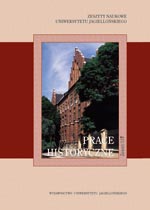Rozwój drukarstwa w Niderlandach w XVI wieku na przykładzie Antwerpii i rola druku podczas antyhiszpańskiego powstania
Development of Typography in the Netherlands in 16th Century on the Example of Antwerp and the Role of Printing during the Dutch Revolt
Author(s): Rafał SzmytkaSubject(s): History
Published by: Wydawnictwo Uniwersytetu Jagiellońskiego
Keywords: Polish history; general history; ancient history; medieval history; modern history; contemporary history; political history; military; economic and social history
Summary/Abstract: The Netherlands and especially Antwerp acted a signifi cant role in developing of printing. The Scheldt city, called one of the three typographical capitals of Europe, was in the 16th century famous of its stock exchange, merchants, skilled artists and craftsmen. All of them where converged by guild of Saint Luke in which very strong position took the fraternity of printers. In the second half of 16th century the main role played there Christoffel Plantijn and his De Gulden Passer publishing house. This article is focusing on the developing of printing in the Netherlands on the example of Antwerp in comparative perspective to other cities in this region and Venice. I’m describing conditions which have had the main infl uence on evolution of printing methods in the metropolis and bringing closer characteristic attributes of Antwerp’s typography as well as fi gures of main printers and publishers. In the second half of 16th century began the revolt against Spanish reign in the Netherlands, which evolved to one of the longest confl icts of Europe – the Eighty Years War. Fighting factions started to use for the first time in history of the propaganda possibilities created by printing. Books and devotional pictures conceded to political texts, pamphlets, leafl ets and broadsheets. The simplicity of manufacture, quickness of duplication and low market price of these prints caused that the propaganda appeared in the modern meaning. Because the role of typography during first twenty years of the Dutch Revolt is hard to overestimate, I’m also pointing main streams of use of such propaganda texts, methods of dissemination and censorship. The fall of Antwerp after one-year siege in 1585 ended a golden age of this metropolis. But the transfer of Weltwirtschaft centre to Amsterdam and later to London didn’t stop Antwerp’s typography. Situated in city publishing houses were still working. Only the variety of publication languages and topics were confi ned to catholic and mostly Spanish and Latin texts.
Journal: Prace Historyczne
- Issue Year: 137/2010
- Issue No: 1
- Page Range: 79-88
- Page Count: 10
- Language: Polish

